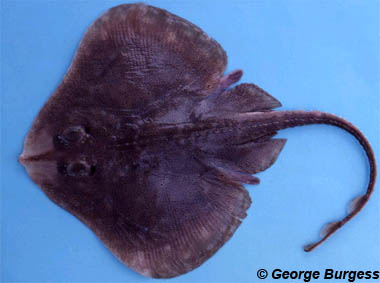
Leucoraja garmani
These deep-water skates have blunt snouts and lobed pectoral fins that are buff to brown on top and pale yellow-white underneath. Their name comes from the groupings, or rosettes, of darker spots on their shoulders and pectoral fins, which differentiate them from the freckled skate.
They live around the outer edge of the continental shelf, eating small crustaceans, and growing to just over 10 inches across. Although they have small thorny denticles long their snout, shoulders, and tail, they are considered harmless to humans because of their habitat depth.
Order – Rajiformes
Family – Rajidae
Genus – Leucoraja
Species – garmani
Common Names
English language common names are rosette skate, leopard skate, and freckled skate. Other common names include raie rosette (French), raya germán (Spanish), and rozetrog (Dutch).
Importance to Humans
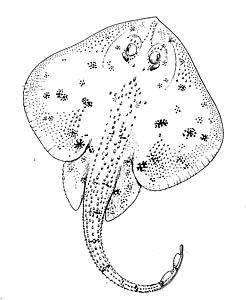
Skates are taken in the New England area by otter trawls as well as bycatch during ground fish trawling and scallop dredge operation. Skate landings decreased dramatically during the 1970s followed by an increase in harvest. This increased fishing pressure was primarily due to demand for bait as well as the marketing of skate wings for human consumption. Rosette skates reach a peak in biomass from 1975-1980 before dropping through 1986. Since that time, numbers of skates overall have been increasing due to numbers of small sized skate species. The rosette skate is not considered to be “over fished” at this time.
Danger to Humans
Rosette skates are considered harmless to humans.
Conservation
The rosette skate is not listed on the World Conservation Union (IUCN) Red List as an endangered or threatened species. The IUCN is a global union of states, governmental agencies, and non-governmental organizations in a partnership that assesses the conservation status of species.
> Check the status of the rosette skate at the IUCN website.
Geographical Distribution
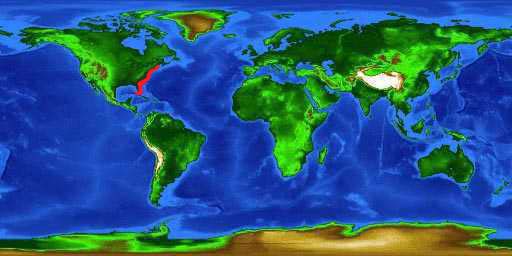
This skate is distributed sub-tropically in the western Atlantic Ocean from the Dry Tortugas in southern Florida north to Nantucket, Massachusetts.
Habitat
Considered a deep water species, rosette skates live over the outer portion of the continental shelf and the upper part of the continental slope from depths of 180-1,800 feet (590-5,905 m). They are found over sand and mud bottoms. Juveniles measuring less than 17.7 inches (45 cm) total length reside along the outer continental shelf throughout the year.
Biology
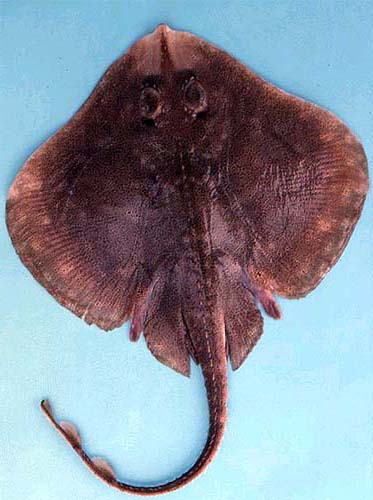
Distinctive Features
The rosette skate has a blunt disc with bulging anterior margins. The outer corners of the pectoral fins are broadly rounded. The tail is approximately 1.5 times as long as the body.
Rarely confused with other species in the western Atlantic Ocean, the dark rosettes for which this species is named distinguishes this skate from all others occurring in the same regional waters. One species that is similar to the rosette skate is the freckled skate (Leucoraja lentiginosa), however this skate has many small freckles but no rosettes on the dorsal surface of the disc.
Coloration
The dorsal surface of the rosette skate is pale buff or brown with small spots of varying shades. There are conspicuous dark rosette markings consisting of 6 or more dark brown or black spots surrounding a central spot. The ventral surface of this skate is white or pale yellow in color. The tail has dark crossbars.
Dentition
The upper jaw of the rosette skate contains 46-52 series of teeth with a few less occurring in the lower jaw. Mature males have teeth that are slightly sharper than those of mature females.
Denticles
Rosette skates have thorns along the ridge of the snout as well as a row around the margins of the eyes. There is also a group of thorns on each shoulder. Young individuals have a row along the midbelt of the back and tail which increases to 2-6 irregular rows in larger specimens. The disc and tail in young specimens are rough with small prickles which are mostly lost as the animal matures, leaving large individuals mostly naked with the exception of the above mentioned thorns. The ventral surface of the rosette skate is smooth.
Size, Age, and Growth
The rosette skate is one of the smaller species of skates, reaching a maximum disc width of 10.2 inches (26 cm) and a maximum length of 17.5 inches (44.5 cm) total length. Males reach sexual maturity at a length of approximately 16 inches (40.6 cm) while females mature at slightly smaller sizes.
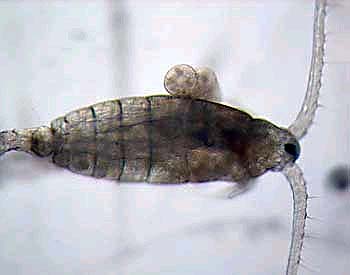
Food Habits
Decapod crustaceans comprise the majority of the rosette skate diet. Amphipods, copepods, polychaetes, squids, octopi and fishes are also eaten by this skate, although to a lesser extent.
Reproduction
Rosette skates are oviparous meaning that the embryos are contained in egg cases which are released into the environment where they continue to develop. Egg cases are found in mature females throughout the year, however they occur more frequently during the summer months.
The amber colored egg cases of the rosette skate are very small, measuring 1.3-1.7 inches (3.4-4.3 cm) in length and 1.0-1.2 inches (2.6-3.0 cm) in width. This small size distinguishes rosette skate egg cases from those of all other skates. The rectagular egg cases have stiff pointed horns located at the corners and are deposited in sandy or muddy flats.
Predators
Potential predators of the rosette skate are larger fish including sharks.
Parasites
There is little known about the parasites of the rosette skate.
Taxonomy
The rosette skate was originally described as Raja garmani by Whitley in 1939. This name was later changed to the currently valid Leucoraja garmani (Whitley 1939). There are no known synonyms used in past scientific literature to refer to this species. The genus name, Leucoraja, is derived from the Greek, leykos meaning “white” and the Latin, raja meaning “a fish”. Leucoraja garmani has been divided into two subspecies, L. garmani garmani which resides between Cape Hatteras and the Dry Tortugas while L. garmani virginica lives in waters north of Cape Hatteras. These two subspecies may actually be two distinct species.
Prepared by: Cathleen Bester